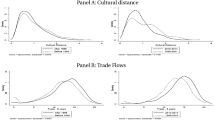Does Cultural Distance Hinder Trade in Goods? A Comparative Study of Nine OECD Member Nations

We examine the effect of cultural distance, a proxy for the lack of a minimum reservoir of trust necessary to initiate and complete trade deals, on bilateral trade flows. Employing data for 67 countries that span the years 1996–2001, we estimate a series of modified gravity specifications and find that cultural dissimilarity between nations has an economically significant and consistently negative effect on aggregate and disaggregated trade flows; however, estimated effects vary in magnitude and economic significance across measures of trade and our cohort of OECD reference countries. The consistently negative influence of cultural distance indicates that policymakers may wish to consider mechanisms that enhance the build-up of trust and commitment when seeking to facilitate the initiation and completion of international trade deals. Our findings also imply that coefficient estimates from related studies that do not account for the trade-inhibiting effect of cultural distance may be biased.
This is a preview of subscription content, log in via an institution to check access.
Access this article
Subscribe and save
Springer+ Basic
€32.70 /Month
- Get 10 units per month
- Download Article/Chapter or eBook
- 1 Unit = 1 Article or 1 Chapter
- Cancel anytime
Buy Now
Price includes VAT (France)
Instant access to the full article PDF.
Rent this article via DeepDyve
Similar content being viewed by others

Cultural Distance and International Trade
Article 07 August 2023

Does Cultural Distance Affect International Trade in the Eurozone?
Chapter © 2020

Does international trade favor proximity in cultural beliefs?
Article Open access 06 June 2022
Notes
“Appendix 1” provides a listing of the countries in our data set.
“Appendix 2” provides details regarding data sources and the construction of the immigrant stock series.
The effect of immigrants on trade between each OECD country–country j pairing can be computed similarly.
The number of trading partners in our analysis is determined by the availability of data on cultural distance. On average, the values surveys provide data for 1,121 residents of each nation in our sample.
“Appendix 3” lists the variables, corresponding data sources and additional notes.
We also estimate the relationship using the Random Effects Generalized Least Squares approach. The results do not differ from those presented here.
References
- Anderson JE (1979) A theoretical foundation for the gravity equation. Am Econ Rev 69(1):106–116 March Google Scholar
- Anderson E, Gatignon H (1996) Modes of foreign entry: a transaction cost analysis and propositions. J Int Bus Stud 17(3):1–26 September doi:10.1057/palgrave.jibs.8490432ArticleGoogle Scholar
- Agarwal S (1994) Socio-cultural distance and the choice of joint ventures: a contingency perspective. J Int Mark 2:63–80 Google Scholar
- Barkema HG, Shenkar O, Vermeulen F, Bell JHJ (1997) Working abroad, working with others: How firms learn to operate international joint ventures. Acad Manage J 40(2):426–442 April doi:10.2307/256889ArticleGoogle Scholar
- Boisso D, Ferrantino M (1997) Economic distance, cultural distance, and openness in international trade: empirical puzzles. J Econ Integration 12(4):456–484 December Google Scholar
- Campbell NCG, Graham JL, Jolibert A, Meissner HG (1988) Marketing negotiations in France, Germany, the United Kingdom, and the United States. J Mark 52(2):49–62 April doi:10.2307/1251264ArticleGoogle Scholar
- Deardorff AV (2004) Local comparative advantage: trade costs and the pattern of trade. Research Seminar in International Economics Discussion Paper #500, University of Michigan
- Dunlevy JA (2006) The impact of corruption and language on the pro-trade effect of immigrants: Evidence from the American States. Rev Econ Stat 88(1):182–186 July ArticleGoogle Scholar
- Eaton J, Tamura A (1994) Bilateralism and regionalism in Japanese and U.S. trade and foreign direct investment patterns. J Jpn Int Econ 8(4):478–510 December doi:10.1006/jjie.1994.1025ArticleGoogle Scholar
- Ghosh S, Yamarik S (2004) Are regional trading agreements trade creating? An application of extreme bounds analysis. J Int Econ 63(2):369–395 July doi:10.1016/S0022-1996(03)00058-8ArticleGoogle Scholar
- Gould DM (1994) Immigration links to the home country: empirical implications for US bilateral trade flows. Rev Econ Stat 76(2):302–316 May doi:10.2307/2109884ArticleGoogle Scholar
- Graham JL, Kim DK, Lin C-Y, Robinson M (1988) Buyer-seller negotiations around the Pacific Rim: Differences in fundamental exchange processes. J Consum Res 15(1):48–54 June doi:10.1086/209144ArticleGoogle Scholar
- Guiso L, Sapienza P, Zingales L (2005) Cultural biases in economic exchange, National Bureau of Economic Research Working Paper No. 11005. NBER, Cambridge Google Scholar
- Hagenaars J, Kalman L, Moors G (2003) Exploring Europe’s basic values map. In: Arts W, Hagenaars J, Halman L (eds) The cultural diversity of European unity. Koninklijke Brill, Boston Google Scholar
- Head K, Ries J (1998) Immigration and trade creation: econometric evidence from Canada. Can J Econ 31(1):47–62 February doi:10.2307/136376ArticleGoogle Scholar
- Hofstede G (1980) Culture’s consequences: international difference in work related values. Sage, Beverly Hills Google Scholar
- Hutchinson WK (2002) Does ease of communication increase trade? Commonality of language and bilateral trade. Scott J Polit Econ 49(5):544–556 November doi:10.1111/1467-9485.00247ArticleGoogle Scholar
- Inglehart R, Basanez M, Diez-Medrano J, Halman L, Luijkx R (eds) (2004) In: Human beliefs and values: a cross-cultural sourcebook based on the 1999–2002 values surveys. Siglo Veintiuno Editores, S.A. de C.V., Mexico City
- International Monetary Fund (IMF) (2007) International financial statistics [computer file]. IMF, Washington, DC (November) Google Scholar
- Kogut B, Singh H (1988) The effect of national culture on the choice of entry mode. J Int Bus Stud 19(3):411–432 September doi:10.1057/palgrave.jibs.8490394ArticleGoogle Scholar
- Larimo J (2003) Form of investment by Nordic firms in world markets. J Bus Res 56(10):791–803 October doi:10.1016/S0148-2963(02)00467-8ArticleGoogle Scholar
- Linders G-J, Slangen A, deGroot HLF, Beugelsdijk S (2005) Cultural and Institutional Determinants of Bilateral Trade. Tinbergen Institute Discussion Paper-TI-2005-074/3, The Netherlands
- Migration Policy Institute (2007) Country and comparative data, Washington, DC. http://www.migrationinformation.org/datahub/comparative.cfm. Accessed November, 2007
- Neal M (1998) The culture factor: cross-national management and foreign venture. MacMillan, Houndmills Google Scholar
- Organization for Economic Cooperation and Development (OECD) (2007) SourceOECD STAN Bilateral Trade Database. http://fiordiliji.sourceoecd.org/vl=7411482/cl=27/nw=1/rpsv/home.htm. Accessed November, 2007
- Ranjan P, Tobias J (2005) Bayes and gravity, WP# 05026. Iowa State University, Ames (October) Google Scholar
- Tadesse B, White R (2007) Cultural distance as a determinant of bilateral trade flows: Do immigrants counter the effect of cultural differences? Appl Econ Lett (in press)
- Tinbergen J (1962) The world economy. Suggestions for an international economic policy. Twentieth Century Fund, New York Google Scholar
- United States Central Intelligence Agency (CIA) (2006) CIA world factbook. https://www.cia.gov/cia/publications/factbook/index.html. Accessed November 2007
- Wagner D, Head K, Ries J (2002) Immigration and the trade of provinces. Scott J Polit Econ 49(5):507–525 December doi:10.1111/1467-9485.00245ArticleGoogle Scholar
- White R, Tadesse B (2007) Immigration policy, cultural pluralism and trade: evidence from the White Australia Policy. Pac Econ Rev 12(4):489–509 October doi:10.1111/j.1468-0106.2007.00368.xArticleGoogle Scholar
- World Bank (2006) World development indicators: CD-ROM version. Development Data Group of the World Bank’s International Economics Department, Washington, DC Google Scholar
Author information
Authors and Affiliations
- Department of Economics, University of Minnesota—Duluth, Duluth, MN, 55812, USA Bedassa Tadesse
- Department of Economics, Franklin and Marshall College, 415 Harrisburg Pike, Lancaster, PA, 17603, USA Roger White
- Bedassa Tadesse
You can also search for this author in PubMed Google Scholar
You can also search for this author in PubMed Google Scholar
Corresponding author
Electronic Supplementary Material
Below is the link to the electronic supplementary material.
ESM 1
Appendices
Appendix 1: country listing
Albania, Algeria, Argentina, Armenia, Australia, Austria, Azerbaijan, Bangladesh, Belgium, Brazil, Bulgaria, Canada, Chile, China, Colombia, Croatia, Czech Republic, Denmark, Dominican Republic, Egypt, El Salvador, Estonia, Finland, France, Germany, Greece, Hungary, Iceland, India, Indonesia, Ireland, Israel, Italy, Japan, Jordan, Korea (Rep.), Latvia, Luxembourg, Macedonia, Mexico, Morocco, Netherlands, New Zealand, Nigeria, Norway, Pakistan, Peru, Philippines, Poland, Portugal, Romania, Russian Federation, Slovak Republic, Slovenia, South Africa, Spain, Sweden, Switzerland, Tanzania, Turkey, Uganda, Ukraine, United Kingdom, United States, Uruguay, Venezuela, Vietnam, Zimbabwe.
Appendix 2: immigrant stock data and estimate construction
Data for Australia, Canada, Denmark, the Netherlands, Norway, Sweden and the US represent foreign-born populations by country of birth, while data for Germany and Italy represent foreign-born populations by country of nationality. Immigrant stock data are from national statistic agencies and have been compiled by the Migration Policy Institute (2007). For six of the nine host countries in our data set, Denmark (Danmarks Statistik), Germany (Statistiches Bundesamt), Italy (Istituto Nazionale di Statistica), Norway (Statistisk Sentralbyrå), the Netherlands (Centraal Bureau voor de Statistiek) and the US (US Census Bureau), immigrant stock data are complete to the extent that the statistical agency provides annual immigrant stock values for the years 1996–2001. Due to a lack of data, immigrant stock values are estimated for 1997–2000, for Australia (Australian Bureau of Statistics) and Canada (Statistics Canada), and for 1996–1998 for Sweden (Statistiska Centralbyrån). Available immigrant stock values are accepted as correct and are employed as benchmark values. Inflow data (reported along with available stock data by the noted statistical agencies) is used to estimate stocks for all other years. For example, immigrant stocks for Canada, for the years 1997–2000, are constructed as \(IM_ = IM_ + \sum\limits_^t \) . IN ijt is the immigrant inflow from country j to country i (in this case, Canada) during year t. is an adjustment factor accounting for return migration and deaths of immigrants during non-benchmark years. The adjustment factor is the immigrant stock from country j in Canada during 2001 less the sum of immigrants from country j in Canada in 1996 and the inflow from country j during the years 1997–2001 divided by five: \(\rho _j = \frac - \left( > \right)>>\) . Immigrant stock variables for Australia and Sweden are estimated similarly.



